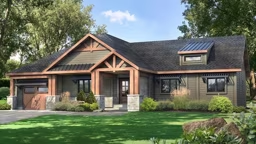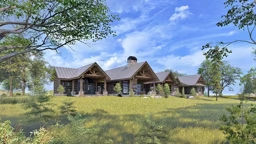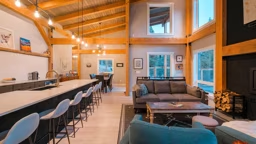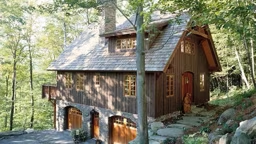
Photo: Maxime Gauthier via Unsplash
Land is a valuable resource. As the saying goes, they aren’t making any more of it. Land also comes in all shapes, sizes – and prices. A postage stamp of a lot near the city can cost as much or more than a great swath of rough acreage in the country. When log or timber home living comes into play, we’re usually talking about the latter. Rural land can be found for cheap, but there’s no shortage of considerations — and potential hidden costs — for turning it into a place to call home. Here’s how to avoid the pitfalls.
Understand Your Land
You’ve done your due diligence and purchased your lot. You performed a title search and know your property lines. You know what’s on the surface as well as what’s beneath it, and now it’s yours. But where you site your home on this property will define how the rest of your land functions, not to mention how much it will cost.Bob Sternquist, president and owner of Timbercraft Homes, has built timber frame and hybrid structures all over the map, both in subdivisions and places completely off the grid. “The big thing I see that surprises clients who haven’t built a custom home before is land development cost,” he says. “We recently had customers who wanted to put their home at the top of a beautiful 14 acre parcel. Then they realized to reach that plateau, the driveway was going to cost $80,000.”
Every situation won’t be quite that drastic or pricey, but little things can add up. HomeAdvisor reports that, in 2020, the cost to build a typical custom home will be $150 to $400 per square foot; and according to The Lenders Network, site work alone can eat up 6 percent of your budget. To get a better handle on expenses, know how the footprint of your house will impact the land.
Ensure Easy Access
Having your own remote acreage affords splendid views, starry nights, freedom and privacy. However, you don’t want to be so remote that getting your log or timber home’s materials to your property blows your budget.“What’s usually not in the forefront of a customer’s mind is how to get materials to the job site,” explains Bob. “You need to make sure there is site accessibility. Sometimes people may build on a spot that has a big switchback, so we have to find a place to be able to off-load then shuttle materials in.” Such a scenario can add time, labor and cost to your build.
“I had a project in Kodiak Island, Alaska, where we shipped everything on a cargo container, then I personally had to shuttle three to five timbers at a time up the driveway because there was no way to get a semi in there to off-load at the job site,” Bob says.
But that’s not the most harrowing delivery Bob has ever had to make. While constructing a church deep in the backwoods of Paradise Falls, Michigan, the rural roads were in such bad shape they actually chose to put materials on a pontoon boat and go back and forth across the river.
The great thing about log and timber home manufacturers is their dedication. If there’s a will, there’s a way. That said, home buyers should know that taking two to three days simply to transport materials to a job site has the potential to seriously impact budgets, labor and timelines.
Connect to Utilities
Living on land that’s off the beaten path doesn’t mean you have to live like a homesteader —unless you want to, of course. From total self-reliance to the luxuries of modernity, personal preferences will determine how you choose to handle power, potable water, waste removal and internet service that will make your log or timber home livable and comfortable.If your home is located a notable distance from other houses or public utilities, connecting to them may be challenging and you could be charged hefty fees to bring services to your property. (It can cost tens of thousands of dollars for a natural gas connection, if you’re far from the main line.) Call your utility provider for quotes early in the process so you aren’t blindsided by the price tag later. Hint: It may actually be less expensive in the long run to set yourself up with a propane tank, a wind turbine or a solar field.
“In many rural areas, you may not have access to public utilities at all,”says Todd Fisher, a builder/owner of Todd Fisher Construction and a Timberhaven Log & Timber Home authorized representative. According to Todd, it is possible to get creative with the way you bring daily conveniences to your property, but if it’s too difficult, not only can it be cost prohibitive, you may have trouble getting the project to pass code. In that case, Todd suggests you look for another spot to build, if possible.
Be Water Wise
If you plan on using well water, as opposed to tapping into municipal water lines, there are a few things to keep in mind. First, the cost to drill the well will depend on how deep you have to dig, but getting to the water isn’t the only cost consideration. You also have to bring it up from the ground. Ten feet of well pipe will hold one gallon of water (about 8 pounds). If you dig a 500-foot well, that’s 50 gallons (or 400 pounds) of water you’re extracting from the earth. It’s doable, but you’ll need a very large (and costly) pump.
In addition, when removing waste matter in a rural locale, a septic system is likely your best bet, but for placement, you’ll need to mind the proximity of your septic field to natural waterways and your county’s zoning rules.
“Before you get your building permit, you’re going to need to perc-approve the land — that’s a percolation test to measure how quickly the soil drains and tell you how big of a septic system you’ll need,” explains Todd. “You’re going to want to find a flat area for the house and the septic field. Most areas have the max incline at 10 to 12 percent.”
Enjoy the Log & Timber Home Life
The placement of driveways, walkways and porches shapes your land and home site, but the topography of your tract may also influence the design of your log or timber home.Many architects and designers preach the importance of a structure harmonizing with its site, rather than imposing itself upon it. A prime example? Don’t build on the prettiest part of your property. Instead, find an area that could benefit from a facelift, and then situate your home to capture the best view.
And for those building in hilly terrain, site your house on the leeward side of a knoll, if you can. This simple tactic can protect your home from wind damage and driving rain, which can do a number on roof shingles, log walls and exposed timber trusses over time.
Keep in mind that building a home involves more than just working around the characteristics of a certain piece of land. When you’re ready to build, Bob offers this advice: “Do your research, shop around and understand the personalities of everyone involved. Find a manufacturer who practices what they preach. It’s a journey.”
After that, use your land as inspiration to create a log or timber home that looks like it grew from the ground up.











